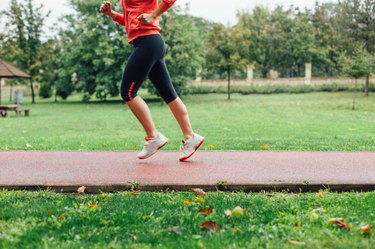
Soreness that occurs several days after running is known as delayed-onset muscle soreness, or DOMS. DOMS pain can last up to seven days but should start to dissipate three to four days after running. If your pain does not diminish two to three days after the initial onset of pain, consult a doctor to rule out a more serious injury or other medical disorder.
Symptoms
Video of the Day
The pain from DOMS typically sets in 24 to 48 hours after running and peaks between 48 and 72 hours afterward. The pain from DOMS usually disappears completely after seven days. In addition to pain, other symptoms can be present, including muscle weakness and tenderness, loss of strength, swelling and stiffness. The symptoms are not dependent on one another and may present themselves at different times, according to researchers at the University of New Mexico. Novice runners and more experienced runners who suddenly increase the intensity or duration of their regimen are most at risk for DOMS.
Video of the Day
Causes
Experts have been unable to determine the exact cause of DOMS, but they do know that it is an inflammatory response, possibly triggered by damage to the muscle cells. It is also known that eccentric exercise -- resistance against lengthening of the muscle -- is the action most responsible for DOMS. Running downhill is one example of eccentric exercise. Unlike an injury, running while afflicted with DOMS does not cause further damage to the muscle. Aching legs can also simply be as a result of joints and connective tissue recovering from the impact of running as well as the muscles recovering. Joint pain may not necessarily be serious and is common with novice runners or people who set out to run after taking a long break.
Treatment
Although research has been done to determine the most effective treatment for DOMS, no one solution has been found that consistently relieves pain or quickens the healing process. Rest can help the healing process, but gentle exercise has been found to relieve the soreness caused by DOMS, albeit only temporarily. Massage, taking a hot bath or taking a non-steroidal anti-inflammatory drug, such as aspirin or acetaminophen, may offer relief. Taking protease enzymes or plant-based sitosterols may help relieve the inflammation caused by DOMS, possibly relieving the pain. But consult a doctor before taking any supplement.
Prevention
The most effective way to prevent DOMS is by warming up and stretching before you run. Both a general warm-up and specific warm-up should be performed. A general warm-up consists of activity that gets your blood moving and warms your entire body; calisthenics are a good example. A specific warm-up entails moving your legs through the motion that you will be performing during exercise, but without resistance. In the case of running, performing leg squats or walking before running are good examples. Gently stretch your legs after warming up and after you are finished running. Pace yourself while running, and avoid running downhill, particularly if you are a beginner. Gradually increase the intensity of your running regimen, avoiding sudden jumps in intensity or duration. Drink plenty of water to stay hydrated and avoid running on sore or fatigued legs. Take at least one day a week to rest your leg muscles.